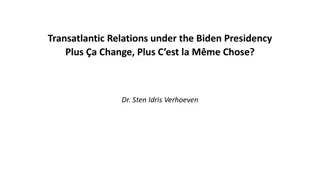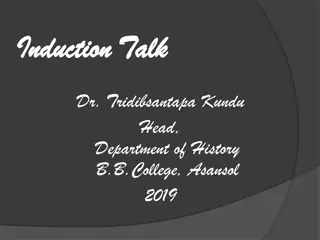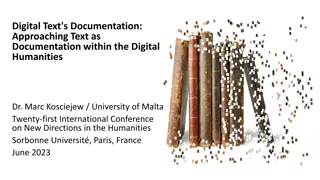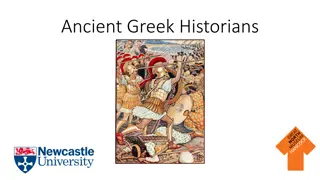Transatlantic Digital Historians Exhibit
Explore the "Transatlantic Digital Historians Exhibit" showcasing objects like the Harris family heirlooms, including a porcelain dish, an oil lamp, and a luxurious hairbrush from their world tour in Japan. Learn about the history and craftsmanship behind these artifacts, offering a glimpse into the late 19th century. Each item tells a unique story of cultural exchange and craftsmanship.
Download Presentation

Please find below an Image/Link to download the presentation.
The content on the website is provided AS IS for your information and personal use only. It may not be sold, licensed, or shared on other websites without obtaining consent from the author.If you encounter any issues during the download, it is possible that the publisher has removed the file from their server.
You are allowed to download the files provided on this website for personal or commercial use, subject to the condition that they are used lawfully. All files are the property of their respective owners.
The content on the website is provided AS IS for your information and personal use only. It may not be sold, licensed, or shared on other websites without obtaining consent from the author.
E N D
Presentation Transcript
Transatlantic Digital Historians Exhibit By: Andrew Carruthers, Andrea Nikola Tonkovic, Dylan Nutbrown and Chelsea Rutherford History 3801: Historian s Craft Dr. Bell November 23rd2016
The Objects: Porcelain dish Brush Oil Dish
This hairbrush was purchased by the Harris family in Japan in 1897 on their world tour. The brush would have been part of a vanity set of the same pattern and design consisting of combs, other brushes and a mirror. The brush s handle and back is made of a single piece of ivory. The brush would have been handmade and carved by Japanese craftsmen.
The porcelain is a unique piece from Japan as it is a piece that would have been owned by a wealthier patron but not designed for export like the ivory brush. The porcelain is very fine and is slightly transparent due to the materials used in its creation and likely has a much higher bone content than other duller pieces. The china dish has a blue and white floral pattern of the typical of the late 19th century.
This Oil Lamp is called a diya which is a lamp designed for ceremonial purposes. The diya is constructed in three different parts, the bottom or base, the middle, and the top. Each part of the diya is shaped and decorated to most likely represent a piece of cultural significance. The object is made of brass, which is a copper/zinc alloy.
Bibliography The Family. Eldon House. last modified 2016. http://www.eldonhouse.ca/eldon-house/the- family/ Wallace Janis. It was a lived-in house. The London Free Press. last modified January 23, 2010. http://www.lfpress.com/homes/news/2010/01/14/12470646.html Von Glasenapp, Helmuth. Jainism: An Indian Religion of Salvation. Delhi: Motilal Banarsidass, 1999. Berry, Thomas. Religions of India: Hinduism, Yoga, Buddhism. New York: Columbia University Press, 1996. John Fuller, Christopher. The Camphor Flame: Popular Hinduism and Society in India. New Jersey: Princeton University Press, 2004. Allocco, Amy. "Snakes, Goddesses, and Anthills: Modern Challenges and Women's Ritual Responses in Contemporary South India." University of Florida, 2009. Fergusson, James. Tree and Serpent Worship: Or, Illustrations of Mythology and Art in India. New Delhi: Asian Educational Services, 2004.
Continued Gillette, Maris. "Copying, Counterfeiting, and Capitalism in Contemporary China: Jingdezhen s Porcelain Industry." Modern China 36, no. 4 (2010): 367-403. doi:10.1177/0097700410369880. Nagatake, Takeshi. Classic Japanese Porcelain: Imari and Kakiemon. Tokyo: Kondasha International, 2003. Impey, Oliver. "Japanese Export Art of the Edo Period and Its Influence on European Art." Modern Asian Studies 18, no. 4 (1984): 685-97. http://www.jstor.org/stable/312344. Finlay, Robert. "The Pilgrim Art: The Culture of Porcelain in World History." Journal of World History 9, no. 2 (1998): 141-87. http://www.jstor.org/stable/20078727. D. Gihwala, L. Jacobson, M. Peisach, C. A. Pineda, and H. N. Vos. "Analysis of Chinese Porcelains and Ceramics." The South African Archaeological Bulletin 40, no. 142 (1985): 96-99. doi:10.2307/3888454.
Continued Marsh, Madeleine. Compacts and Cosmetics: Beauty from Victorian Times to the Present Day. Casemate Publishers, 2014. 48-52. ttps://books.google.ca/books?id=mkzWCwAAQBAJ&printsec=fro ntcover#v=onepage& q&f=false. Nagatake, Takeshi. Classic Japanese Porcelain: Imari and Kakiemon. Tokyo: Kondasha International, 2003. The Family. Eldon House. last modified 2016. http://www.eldonhouse.ca/eldon-house/the-family/ Von Glasenapp, Helmuth. Jainism: An Indian Religion of Salvation. Delhi: Motilal Banarsidass, 1999. Wallace Janis. It was a lived-in house. The London Free Press. last modified January 23, 2010. http://www.lfpress.com/homes/news/2010/01/14/12470646.html























